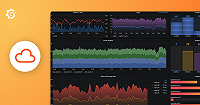This is documentation for the next version of Pyroscope. For the latest stable release, go to the latest version.
Set up Go profiling in pull mode
In pull mode, the collector, whether Grafana Alloy (preferred) or Grafana Agent (legacy), periodically retrieves profiles from Golang applications, specifically targeting the
/debug/pprof/* endpoints.
To set up Golang profiling in pull mode, you need to:
- Expose pprof endpoints.
- Install a collector, either Grafana Alloy (preferred) or Grafana Agent (legacy).
- Prepare the collector’s configuration file.
- Start the collector.
Expose pprof endpoints
Ensure your Golang application exposes pprof endpoints.
Get
godeltaprofpackagego get github.com/grafana/pyroscope-go/godeltaprof@latestImport
net/http/pprofandgodeltaprof/http/pprofpackages at the start of your application.import _ "net/http/pprof" import _ "github.com/grafana/pyroscope-go/godeltaprof/http/pprof"
Install the collector
This procedure can be used with either Grafana Alloy or Grafana Agent collector. You can use the sample collector configuration file to send data to Pyroscope. This configuration file works for either Grafana Alloy or Grafana Agent in Flow mode.
Grafana Alloy is the preferred collector.
To install Alloy, refer to Grafana Alloy installation.
Caution
Grafana Alloy is the new name for our distribution of the OTel collector. Grafana Agent has been deprecated and is in Long-Term Support (LTS) through October 31, 2025. Grafana Agent will reach an End-of-Life (EOL) on November 1, 2025. Read more about why we recommend migrating to Grafana Alloy.
If you are using legacy Grafana Agent Flow, use the Grafana Agent in Flow mode documentation to install.
Prepare the collector configuration file
In the Grafana Alloy or Grafana Agent Flow configuration file, you need to add at least two blocks: pyroscope.write
and pyroscope.scrape.
Add
pyroscope.writeblock.pyroscope.write "write_job_name" { endpoint { url = "http://localhost:4040" } }Add
pyroscope.scrapeblock.pyroscope.scrape "scrape_job_name" { targets = [{"__address__" = "localhost:4040", "service_name" = "example_service"}] forward_to = [pyroscope.write.write_job_name.receiver] profiling_config { profile.process_cpu { enabled = true } profile.godeltaprof_memory { enabled = true } profile.memory { // disable memory, use godeltaprof_memory instead enabled = false } profile.godeltaprof_mutex { enabled = true } profile.mutex { // disable mutex, use godeltaprof_mutex instead enabled = false } profile.godeltaprof_block { enabled = true } profile.block { // disable block, use godeltaprof_block instead enabled = false } profile.goroutine { enabled = true } } }Save the changes to the file.
Start the collector
Start a local Pyroscope instance for testing purposes:
docker run -p 4040:4040 grafana/pyroscopeStart the collector:
- To start Grafana Alloy v1.2: Replace
configuration.alloywith your configuration file name:alloy run configuration.alloy - To start Grafana Alloy v1.0/1.1: Replace
configuration.alloywith your configuration file name:alloy run --stability.level=public-preview configuration.alloyThestability.leveloption is required forpyroscope.scrapewith Alloy v1.0 or v1.1. For more information aboutstability.level, refer to The run command documentation. - To start Grafana Agent, replace
configuration.riverwith your configuration file name:grafana-agent-flow run configuration.river
- Open a browser to http://localhost:4040. The page should list profiles.
Examples
Send data to Grafana Cloud
Your Grafana Cloud URL, username, and password can be found on the “Details Page” for Pyroscope from your stack on grafana.com. On this same page, create a token and use it as the Basic authentication password.
pyroscope.write "write_job_name" {
endpoint {
url = "<Grafana Cloud URL>"
basic_auth {
username = "<Grafana Cloud User>"
password = "<Grafana Cloud Password>"
}
}
}Discover Kubernetes targets
- Select all pods
discovery.kubernetes "all_pods" {
role = "pod"
}Drop not running pods, create
namespace,pod,nodeandcontainerlabels. Composeservice_namelabel based onnamespaceandcontainerlabels. Select only services matching regex pattern(ns1/.*)|(ns2/container-.*0).discovery.relabel "specific_pods" { targets = discovery.kubernetes.all_pods.targets rule { action = "drop" regex = "Succeeded|Failed|Completed" source_labels = ["__meta_kubernetes_pod_phase"] } rule { action = "replace" source_labels = ["__meta_kubernetes_namespace"] target_label = "namespace" } rule { action = "replace" source_labels = ["__meta_kubernetes_pod_name"] target_label = "pod" } rule { action = "replace" source_labels = ["__meta_kubernetes_node_name"] target_label = "node" } rule { action = "replace" source_labels = ["__meta_kubernetes_pod_container_name"] target_label = "container" } rule { action = "replace" regex = "(.*)@(.*)" replacement = "${1}/${2}" separator = "@" source_labels = ["__meta_kubernetes_namespace", "__meta_kubernetes_pod_container_name"] target_label = "service_name" } rule { action = "keep" regex = "(ns1/.*)|(ns2/container-.*0)" source_labels = ["service_name"] } }Use
discovery.relabel.specific_pods.outputas a target forpyroscope.scrapeblock.pyroscope.scrape "scrape_job_name" { targets = discovery.relabel.specific_pods.output ... }
Exposing pprof endpoints
If you don’t use http.DefaultServeMux, you can register /debug/pprof/* handlers to your own http.ServeMux:
var mux *http.ServeMux
mux.Handle("/debug/pprof/", http.DefaultServeMux)Or, if you use gorilla/mux:
var router *mux.Router
router.PathPrefix("/debug/pprof").Handler(http.DefaultServeMux)

